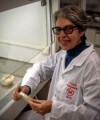Actualidad
Plumbagin: A Natural Compound to Control Gray Mold
Plumbagin controls postharvest fungal pathogens by affecting the metabolism and inducing autophagy in fungi
Fungal pathogens represent a substantial economic threat to agricultural production. Their control is essential for the postharvest industry.
Gray mold caused by Botrytis cinerea (Ascomycota) is one of the most destructive postharvest diseases, causing severe decay in a wide range of fruits and vegetables, including grapes, cherries, strawberries, and tomatoes.
In recent decades, the control of B. cinerea has heavily relied on synthetic fungicides. However, overuse has raised growing concerns about food safety and environmental contamination.
Additionally, the excessive reliance on synthetic fungicides and the high genetic variability of B. cinerea have led to the emergence of resistant strains. Therefore, there is an urgent need for safe and effective alternative strategies to control this phytopathogen.
Plant-derived antifungal substances have recently received wide attention due to their safety, accessibility, and efficient activities. Furthermore, multiple plant-derived antifungal substances have been reported to have antifungal effects on B. cinerea.
Plumbagin
Plumbagin is a natural naphthoquinone compound extracted from Plumbago species. Widely distributed, this plant from the Plumbaginaceae family consists of shrubs or lianas, with adaptations to survive in mountainous, cold, and dry environments or saline habitats. It has ornamental as well as medicinal value.
Plumbagin exhibits various biological and pharmacological activities, including antioxidant, anti-inflammatory, antibacterial, and anticancer activities.
Antifungal Activity
Research on the antifungal activity of plumbagin has primarily focused on in vitro studies. It has been reported that this substance inhibits the development of Aspergillus sp., Candida sp., Fusarium sp., and Penicillium sp.
A recent study examined the inhibitory effect of plumbagin on B. cinerea both in vitro and in vivo and verified the underlying mechanisms involved.
The potential mechanism of plumbagin on B. cinerea studied through transcriptomics shows that it is a broad-spectrum antifungal activity and completely inhibits the growth of various postharvest pathogens at a concentration of 20 mg L-1 in vitro, acting at the spore germination level.
Transcriptomic analysis also indicated that plumbagin significantly affects metabolic processes and induces autophagy* in B. cinerea.
These results suggest that plumbagin is a promising broad-spectrum plant-derived fungicide that suppresses postharvest gray mold by affecting the metabolism of B. cinerea and inducing autophagy, providing a basis for controlling pathogens during this period.
*Autophagy (or autophagocytosis) is a cellular catabolic process that leads to the degradation of a cell's own components through the lysosomes.
Sources
Zhang, X.; Chen, Y.; Chen, T.; Li, B.; Tian, S. (2024). Plumbagin controls fungal postharvest pathogens by affecting metabolism and inducing autophagy Postharvest Biology and Technology, 212: 112904.
Plumbago - Wikipedia Accessed on 17/06/2024.
Plumbagin - Wikipedia Accessed on 17/06/2024.
Image
Gray Mold of Grape - Botrytis cinerea Accessed on 17/06/2024.













